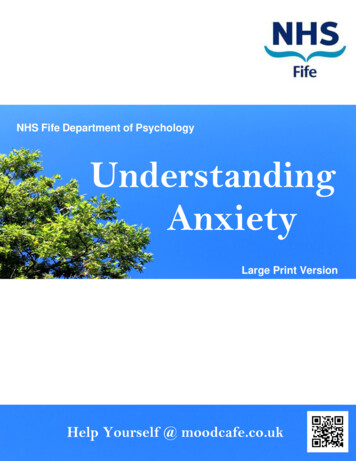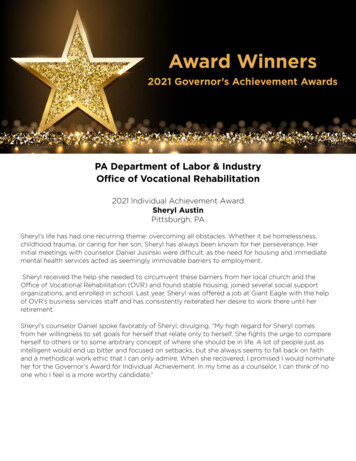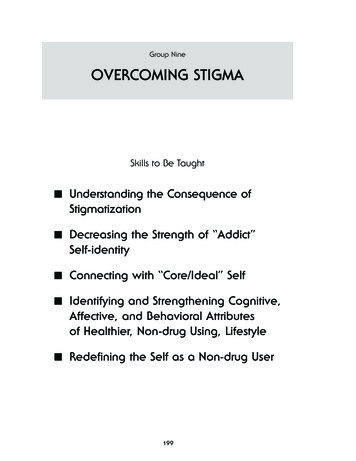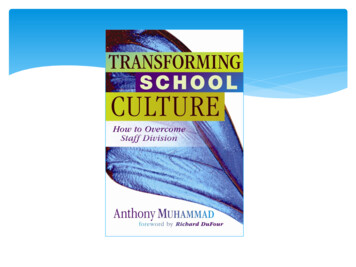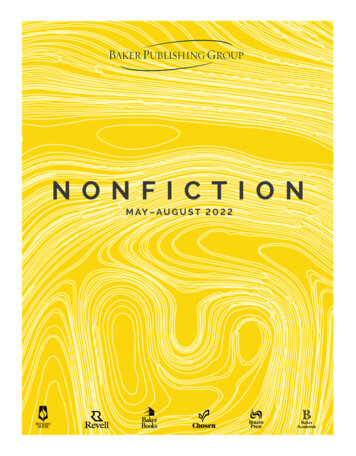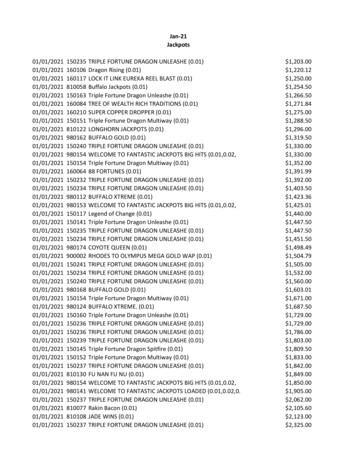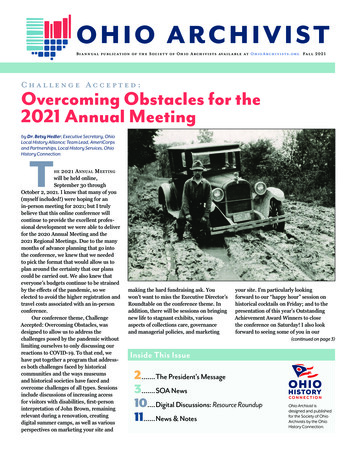
Transcription
Biannual publication of the Society of Ohio Archivists available at OhioArchivists.org Fall 2021C ha ll eng e Accepted:Overcoming Obstacles for the2021 Annual Meetingby Dr. Betsy Hedler, Executive Secretary, OhioLocal History Alliance; Team Lead, AmeriCorpsand Partnerships, Local History Services, OhioHistory ConnectionThe 2021 A nnual M eetingwill be held online,September 30 throughOctober 2, 2021. I know that many of you(myself included!) were hoping for anin-person meeting for 2021; but I trulybelieve that this online conference willcontinue to provide the excellent professional development we were able to deliverfor the 2020 Annual Meeting and the2021 Regional Meetings. Due to the manymonths of advance planning that go intothe conference, we knew that we neededto pick the format that would allow us toplan around the certainty that our planscould be carried out. We also knew thateveryone’s budgets continue to be strainedby the effects of the pandemic, so weelected to avoid the higher registration andtravel costs associated with an in-personconference.Our conference theme, ChallengeAccepted: Overcoming Obstacles, wasdesigned to allow us to address thechallenges posed by the pandemic withoutlimiting ourselves to only discussing ourreactions to COVID-19. To that end, wehave put together a program that addresses both challenges faced by historicalcommunities and the ways museumsand historical societies have faced andovercome challenges of all types. Sessionsinclude discussions of increasing accessfor visitors with disabilities, first-personinterpretation of John Brown, remainingrelevant during a renovation, creatingdigital summer camps, as well as variousperspectives on marketing your site andmaking the hard fundraising ask. Youwon’t want to miss the Executive Director’sRoundtable on the conference theme. Inaddition, there will be sessions on bringingnew life to stagnant exhibits, variousaspects of collections care, governanceand managerial policies, and marketingyour site. I’m particularly lookingforward to our “happy hour” session onhistorical cocktails on Friday; and to thepresentation of this year’s OutstandingAchievement Award Winners to closethe conference on Saturday! I also lookforward to seeing some of you in our(continued on page 3)Inside This Issue2.The President’s Message3.SOA News10.Digital Discussions: Resource Roundup11.News & NotesOhio Archivist isdesigned and publishedfor the Society of OhioArchivists by the OhioHistory Connection.
OHIO ARCHIVISTEditor-in-Chief:Abigail SachsAssistant Editors:Vacant, Features EditorJenni Salamon, Digital DiscussionsJessica Heys, News & NotesProduction & Design:Betsy Hedler, Production EditorKim Koloski, Graphic DesignSOA LEADERSHIPOFFICERSPresidentSherri Goudy, 2020-2021Nerd Girl History AdventureIndependent Archivist, Researcher andWriterVice President / President-ElectAmy RohmillerAssociate University ArchivistRoesch Library, University of DaytonSecretaryJen JohnsonDigitization Consultant and Ohio DigitalNetwork Project CoordinatorState Library of OhioTreasurerLisa Rickey, 2020-2022Archivist/Collections ManagerWright State University LibrariesCOUNCIL MEMBERSMelissa Dalton, 2020-2022Public Outreach CoordinatorGreene County Records Center & ArchivesSasha GriffinUniversity Archivist and SpecialCollections Librarian, Denison UniversityEX–OFFICIOPast–PresidentRobin Heise, 2019-2020Records Manager/ArchivistGreene County Records Center andArchivesEditor, Ohio ArchivistKayla Harris, 2018-2021Archivist / Librarian, The Marian Library,University of DaytonThe President’s MessageDear SOA Members,I am writing this message to you just one monthafter our annual meeting themed “Archives in an Era ofChange.” In that time, access to honest history continuesto be threatened. As historians, scholars, and educatorsseek to tell the truth while also disrupting the myths andnostalgic interpretations of America’s past, there is aconcerted effort to bemoan that we cannot revise historyand doing so is erasing and tarnishing our past.The way we interpret and analyze the past, particularly as previously neglected and ignored stories are brought to light, is the work ofhistorians. Historical revisionism is absolutely necessary and integral to our work.As I stated at the annual meeting, we as archivists are in an important position. Thesignificance of our work while history and education are being attacked in states acrossour nation could not be more critical. We are in a place to do something about it.And we are.I am so proud of the work SOA members are doing right now. From changing thelanguage in our finding aids to be more specific of the communities they describe andconnect to, to amplifying the voices in our communities to share their stories, archivistsare working with communities, in some cases letting the communities lead the projects.Organizations are providing space for communities to access their truth, and to telltheir truths. Archivists are acknowledging the emotional labor of this work, and the painand trauma as well as the joy and healing that staff, volunteers, and communities mayexperience. These are the ways we dismantle the archaic hierarchal power structures ourarchival institutions were founded on.More importantly, these are the ways we can perfect our democracy. We are listeningand learning, acknowledging privilege and bias, and we are working with one anotherand communities in efforts to create a level playing field. We are lifting up those whoare already actively doing this work and providing support and platform rather thanco-opting the work as our own. We are working with – a concept being fostered at oneof the non-profit foundations I work with, which asks what our democracy can be if wedefine it as not just “of, by, and for” the people, but “with” the people. Imagine whatarchives can look like when this same theory is applied, working not simply of, by, and forthe community, but truly with the community.The events that have shaped our lives over the past year have a valuable lesson forus: adaptation. The Pandemic has revealed that we can adapt our focus – creating accessthrough digital means. Protest movements have shown us that history is happening rightnow, and that we can provide access to the stories of the current moment from those whoare directly experiencing it. We can provide access without ownership. We can dismantle.We can speak truth to power.We can adapt.I hope that we are up for the challenge. In the end, it is the people, not the paper,that matters. Sherri Goudyshe/her/hersPresident, Society of Ohio Archivistssherrigoudy14@gmail.comSOA MissionFounded in 1968, the Society of Ohio Archivists’ mission is toimprove the state of archives in Ohio by promoting the archivalprofession and providing professional development and networkingopportunities for Ohio’s professional and aspiring archivists.Ohio Archivist Fall 2021 2
Cover Story (continued from page 1)virtual networking space/registration desk space.To keynote this thread, weare very excited to welcome Dr.Anna-Lisa Cox as this year’splenary speaker, sponsored byOhio Humanities. Dr. Cox isan award-winning Americanhistorian who specializes in thehistory of racism in the 19thcentury, with a focus on theNorth. Her original researchunderpinned two exhibits atthe Smithsonian’s NationalMuseum of African AmericanHistory and Culture, and heressays are featured in a numberof publications including TheWashington Post, Lapham’sQuarterly, the SmithsonianMagazine, and The NewYork Times. Her recent book, The Bone and Sinew of the Land,on the long-denied history of African American pioneers whosettled the Midwest before the Civil War, was honored by theSmithsonian Magazine as one of the best history books of 2018.Professor Henry Louise Gates Jr. praised it for being “a revelationof primary historical research that is written with the beauty andempathic powers of a novel,” and New York Times best-sellingauthor Professor Ibram Kendi lauded it for being a “groundbreaking work of research.”In addition to frequently being invited to lecture at universities and other organizations nationally and internationally, sheis an in-demand guest on radio and television shows, includingNPR’s All Things Considered. Dr. Cox is a Non-Resident Fellowat Harvard University’s Hutchins Center for African and AfricanAmerican Research. She is at work on two new book projects,including one on the African Americans who surrounded andinfluenced the young Abraham Lincoln.Check our website for registration details and the full programas it is finalized. We will be mailing the full program to members inJuly. Please contact us at ohiolha@ohiohistory.org with anyquestions.SOA NewsArchives Month 2021October is Archives Month and the theme for the 2021 Society of Ohio Archivists poster is“Ohio’s Wonderland: Unboxing the Great Outdoors”, which features archival images fromrepositories across Ohio that highlights nature, and outdoor recreation and tourism in thestate.During the past year, many have been cooped up indoors and apart from others morethan ever before, but the outdoors have always offered an escape! With this in mind, wedecided to showcase Ohio’s outdoor spaces. There were dozens of images submissionsfrom a wide variety of archives. Images included parks, hikes, picnics, outdooramusements, and more!We want to thank everyone who submitted and encourage people to watch theirmailboxes for the final poster near October. In the fall, look for a map companion to theOhio Archives Passport, which includes listings for Ohio archives, on the SOA website.Keep an eye out for announcements about archival events happening during ArchivesMonth and be sure to share information about your own local events happeningthroughout the month.— From the Advocacy and Outreach CommitteeOhio Archivist Fall 2021 3
SOA News2 0 2 1 A n nual Conferenc e R e c a p:Archives in an Era of ChangeBy Rachael Bussert, Dayton Metro Library, and William Modrow, MiamiUniversity, Educational Programming Committee Co-ChairsThe Society of Ohio Archivists came together for avirtual meeting on June 7-8, 2021, due to the COVID-19pandemic. The Educational Programming Committeechose the theme, “Archives in an Era of Change” for the2021 Annual Meeting. Archives have been confronted withthe obstacles of research rooms closing to the public, jobloss and under-employment, and social justice issues thatcontinue to shape the landscape of the United States andchallenge us to look inward and address equity within thearchives profession. This year featured an outstandingplenary, five sessions, a virtual tour of three institutions,and posters presented in the lightning round format.The Educational Programming Committee would liketo thank Betsy Hedler and Jenni Salamon from the OhioHistory Connection for providing Zoom support throughout the meeting. We continue to thank our presenters andour membership for being flexible while we come togetherin a virtual format and look forward to meeting in-personagain.Plena ry:Archives, Libraries, Museums:Meaning-making and MagicPresenters: Ben Garcia is Deputy Executive Director and Chief LearningOfficer at the Ohio History Connection.Synopsis: Adam WanterDay two of the virtual conference opened with our PlenarySpeaker Ben Garcia. Mr. Garcia is the Deputy Executive Directorand Chief Learning Officer at the Ohio History Connectionwhere he leads special projects and oversees six divisions.Prior museum experience includes tenures at the J. Paul GettyMuseum, the Skirball Cultural Center, the Phoebe A. HearstMuseum of Anthropology at UC Berkeley, and the Museumof Us. Ben serves on the boards of Equality Ohio and theAssociation of Midwestern Museums. Mr. Garcia provideda vivid and enthralling account of his own personal journey,detailing the profound ways that libraries and archives played.Mr. Garcia then pivoted to discussing many of the issues thatour field currently faces, such as equitable practice, access, andrepresentation in our fields. The plenary ended with a rousingand thought provoking Q&A, where the idea of vocational awewas discussed and examined.Se s s io n:Who Controls the Vocabulary?:Reviewing and Implementing CommunityBased LGBTQ Descriptive TermsPresenters: Karen Robertson and Lisa Wood, Ohio History ConnectionSession synopsis: Sherri Goudy, Nerd Girl History AdventureSOA’s Annual Meeting kicked off with this session by KarenRobertson and Lisa Wood from the Ohio History Connection.Karen and Lisa guided us through ways in which we can rethinkthe vocabulary that describes our collections. They helped us envision a path to return the control of vocabulary used to describecollections back to the community. Following their example ofadjusting the descriptive language in OHC’s LGBTQ collections,Karen and Lisa provided lessons and practical tools to aid anyonewho is considering this type of project.Karen began the session by describing their vocabularyreview project at OHC. The goal: to prepare and implement a newlist of subject headings that can be used with collections about theLGBTQ community. The project developed organically throughan effort to use more specific and relevant subject headings, suchas “bisexual people” and “transgender.” The archivists at OHCbegan to ask themselves why they shouldn’t use such specificterms, especially when these are the terms that the communityuses. Considering the community where the collections originatedas well as the communities who would be using the collectionsis really important, as well as having people from that specificcommunity participate and be part of the decision-making processand having a diverse staff and volunteers. However, Karen statedthat the community deserves control even if they aren’t in thearchive staff.They also walked us through resources and tools that aidedin tackling the project at OHC. This included staff trainingthrough Equitas Health as well as support from the entireinstitution, as well as seeking out others who had done thiskind of work before. Some of those projects they recommendedinclude: The Archives for Black Lives in Philadelphia anti-racistdescription resources, the Power of Words Handbook by theNational Japanese American Civic League, and Historic NewOrleans Collection catalog statement on harmful language.Another great resource that Karen discussed was Homosaurus,a vocabulary tool that uses vocabulary created by LGBTQ archivists for LGBTQ archivists.Lisa, as the cataloger in this work, provided some greatconsiderations for anyone who may embark on this type ofwork. One major perspective: how necessary is this work? Dopeople even pay attention to the subject headings? Karen andLisa both discussed and recommended the Change the Subjectdocumentary as essential viewing. Lisa discussed that this filmprovides a real-world example of how important this work trulyis and can even be a tool in encouraging your institution to do(continued on page 5)Ohio Archivist Fall 2021 4
continued from page 4this type of project, and that this needs to be a top priority.Final perspective: one term alone can have a huge impact. Lisaproved this by telling us about her quest to change the term“internment” to “incarceration” when describing what happenedto Japanese Americans during WWII.Lisa and Karen’s presentation provided great tools for allof us, even small starting points for those of us who may be ininstitutions and historic sites where a large-scale project maynot be possible. Changing just one term could be easy and a wayto open the door to continued inclusive changes. As Karen said,“even small change is change.” We can all continue learning andlistening.The biggest lessons include who controls and who weconsider when doing this type of work. First, the communitiesdeserve control – the community has the most to lose (and gain)from the terms we choose, so we should always consult with thecommunity, represent the community, and make sure that ourwork centers the community being able to find the collections.Second, always consider the emotional labor, especially for thosein the community.S es sio n :Creative Collaboration, TransformativeTimes: Teaching with Archival andPrimary SourcesPresenters: Kristina Schulz, Heidi Gauder, Kayla Harris, and BridgetRetzloff, University of DaytonSession synopsis: Jolie Braun, The Ohio State UniversityIn this panel, Kristina Schulz, Heidi Gauder, Kayla Harris,and Bridget Retzloff presented on in-person and virtual instruction sessions that introduced undergraduates to the Universityof Dayton’s archival collections. All four were collaborationswith the university’s residency program AVIATE (A Vision forIntegrated, Applied, and Transformative Education) whichpromotes active learning through campus partnerships.Kristina Schulz discussed her in-person workshop, “HowDiversity Made Baseball a Better Game,” which examined MajorLeague Baseball during the Civil Rights Movement. Usingbaseball cards from the Marion Jacobs Baseball Collection,students participated in activities, such as creating a fantasybaseball draft, that highlighted the impact of integration onbaseball and how it helped improve the game.In “Dayton Patented,” Heidi Gauder presented on usingpatents to teach students about Dayton history and libraryresources. Students used a database to retrieve patent information, worked with the librarians to find local addresses forDayton-area inventors, and then added this data to a GoogleMyMap. Notably, during the discussion at the end of the session,Gaudet talked with the group about how their pool of inventorshad few women or people of color, using it as an opportunity toacknowledge gaps in historical records and archival collections.Kayla Harris’s “On Paper: Nativity Imagery from the MarianLibrary: Online Exhibits and Special Collections” described usinga digital exhibit to teach students about the Marian Library’scollections and nativity imagery. Harris created a virtual activitythat guided participants through the exhibit with a combinationof text, image, and video. Many students provided feedback thatthey appreciated that the asynchronous format allowed themto work at their own pace and some noted that they enjoyedlearning about artifacts while being asked open-ended questionsthat encouraged them to reflect on their own experiences.In “Handwriting and Archival Documents,” Bridget Retzloffspoke about using historical materials to teach undergraduatesabout the history of handwriting. Students who attendedthis virtual session learned about handwriting and its role ineducation as well as about transcription crowdsourcing projects.They also practiced reading and transcribing archival documentswritten in cursive.For those interested in learning more about these sessions,the presenters created a LibGuide with additional informationand resources.Se s s io n:“Making It Work(flow): New Employees inan Era of Change”Presenters: Brenna Edwards, Karolina “Kay” Lewandowska,Stephanie Luke, Kathryn SloverSession synopsis: Vic FleischerKathryn Slover, Digital Archivist at The University of Texasat Arlington Special Collections, introduced the topic and whatwould be covered in the session, including workflows, especiallyduring the pandemic, individual stories, best practices, andlessons learned. She started with definitions, including workflow,onboarding, documentation, and assumptions and talked aboutwhy workflows and documentation are important. She also talkedabout working with what was there versus starting from scratch,or taking existing documentation and enhancing it. She alsotalked about lessons learned, including communication is key,writing everything down, and that you can’t change everything ina day.Stephanie Luke, Metadata Librarian for Special Collectionsat the University of Texas at Arlington Libraries, talked aboutcataloging special collections and archival collections, especiallythe lack of documentation on cataloging procedures and workflows. She covered what was implemented at her institution andcreating new documentation. She also covered lessons learned,including the importance of documentation and workflow.Brenna Edwards, Manager for Digital Archives at theHarry Ransom Center at The University of Texas at Austin,talked about working remotely and doing detective work to findexisting documentation, especially for remote work, which didn’texist. Therefore, she talked about creating documentation andworkflows and mentioned lessons learned, including importanceof documentation and reaching out to those in the positionpreviously to help piece things together.Karolina “Kay” Lewandowska, Records Manager atCommander, Navy Installations Command, mentioned howshe started after her institution sent everyone home due to thepandemic and the lack of documentation and workflow. Shestated that the existing outflow was outdated so she decidedto start from scratch, with the outcome to make it easier forher successors. She also talked about how she helped to buildinstitutional knowledge that will outlive her and covered what(continued on page 6)Ohio Archivist Fall 2021 5
continued from page 5she learned, including the need for better documentation andorganizational files.Brenna concluded the session by covering keys to successfuldocumentation and workflow, including reviewing currentdocumentation and workflows and creating them for others,especially your successors. She also stressed the importance ofwriting everything down, using screenshots and diagrams, andthe need to review and update documentation as needed andkeeping track of changes and updates. Finally, she stressed theimportance of collaboration and testing the documentation andworkflows and providing feedback. She also covered tools forcreating documentation like Box, GitHub, Trello, and others.S es sio n :Virtual Archives CrawlPresenters: Kristina Schulz and Amy Rohmiller, University of Dayton,Rachel Makarowski and Candace Pine, Miami University, Gino Pasi, TheHenry R. Winkler Center for the History of the Health Sciences, University ofCincinnatiSession synopsis: Rachael Bussert, Dayton Metro LibraryAlthough many reading rooms have been closed to the publicin 2020 and 2021 attendees at the Annual Meeting were stilltreated to a tour of three archival collections. The first VirtualArchives Crawl was led by tour guides from the University ofDayton, Miami University, and the Henry R. Winkler Center at theUniversity of Cincinnati.Kristina Schulz and Amy Rohmiller presented a tour of theUniversity Archives and Special Collections at the University ofDayton. Tour highlights included items from the Miriam JacobsBaseball Memorabilia Collection and athletic memorabilia suchas a fan-created statue of the UD football team with coach, HarryBaujan. Attendees were also shown a scrapbook documentingthe first four years of women on campus. The scrapbook heldautographs from both Eleanor Roosevelt and Judge Florence E.Allen.Rachel Makarowski and Candace Pine led a tour of thespaces and unique items at the Miami University SpecialCollections. Attendees were walked through new and updatedspaces from the 2015 renovations including cold storage, theExhibition Room, and state of the art digitization lab. They werealso treated to a glimpse of a volume of Shakespeare’s First Folioand the Native American Women Playwrights Archive, as well ashistoric postcards and World War Two-era student diaries datedfrom 1942-1950.Gino Pasi led a tour of The Henry R. Winkler Center for theHistory of the Health Sciences at the University of Cincinnati.Starting at the R Level of the Winkler Center, Pasi walkedattendees through unique items in their medical collectionsincluding items from the collections of Bruce Sabin and HenryHeimlich. Attendees also were intrigued by sketches from theDaniel S. Young Civil War Medical Drawings and plates fromMascagni’s Most Splendid Anatomy Ever Published. The tourended with a look at instruments used in medical practices thatwould later be known as quackery.Se s s io n:Amplifying Diverse Voices: Documentingthe History of UnderrepresentedCommunities at Two Ohio UniversitiesPresenters: Victor Fleischer, University of Akron, Matthew Francis, OhioNorthern UniversitySynopsis: William ModrowAs many archivists/archives, libraries and other organizations& individuals begin to address the importance of Diversity, Equity& Inclusion, the Ohio Northern University and The University ofAkron have undertaken several projects recently that highlightdiverse voices, including women, the LGBTQ community, peoplewith disabilities, and especially Asian & African Americans.Vic & Matt discussed how they approached their institutions(administrators) for support including funding, how they workedcreating outreach opportunities within the campus communityand the community at large. This only strengthens the tiesbetween the universities and the local communities, many for thefirst time. The interactions from people in underrepresented areasprovided new stories and many teaching/learning experiences asthese unheard stories were being revealed.Both speakers elaborated on the increase in opportunitycreating important oral histories among these diverse voices. Aswith any new projects in these areas there may be pushback, butVic & Matt encouraged attendees not to be afraid of controversywhen working on these types of projects as some may encounterunpopular materials or responses when creating these materials.A great success of Vic & Matt’s work included the positive feedback they received and the possibility for more of these projects!Se s s io n:Lightning Round Poster SessionsFour amazing poster sessions discussing various projects andoutcomes from a wide range of institutions.Synopsis: William ModrowThe Game’s Afoot: Introducing Students toArchival ResourcesPresenter: Amy Rohmiller, The University of DaytonOne important & fun way to reach the campus community isthrough gaming. Amy discussed how using UD’s digital collectionsthey were able to create outreach opportunities, through gaming,among the students at the University of Dayton. Attendees wereintroduced to resources, materials and staff to increase theirawareness of the opportunities, collections and services availableto them. Amy included tips, suggestions and ideas how SOAattendees could create these types of gaming programs.#ThrowbackThursday Reinvented:A Communications and Archives CollaborationPresenters: Sarah Aisenbrey and Michelle Bodine, Sisters of the PreciousBloodIt is always challenging using social media to promote one’scollections, services or as a means for outreach. It also can be a(continued on page 7)Ohio Archivist Fall 2021 6
continued from page 6great opportunity. Sarah from the Communications and ArchivesDepartments for the Sisters of the Precious Blood discussed howwell this worked for them increasing awareness and reachinga nationwide network. Using images from the collections, theywere able to interact through Facebook & twitter to establishconnections with alumni.Traditional Description and Untraditional Instructionin the ArchivesPresenter: Suzanne Reller, University of CincinnatiArchivists & librarians have constantly worked for years makingmaterials in their collections more accessible through variousmeans such as finding aids. Often we have struggled to explainthese to students & researchers. Suzanne discussed how toimprove finding aid instruction resulting in more access to collections. She also shared the need to restructure online tutorials tomake them more relevant and the importance of building findingaids into the general Information management system available atone’s institution.Preserving our Connections: Crafting InstructionOpportunities from Serendipitous EncountersThey opened with a timeline of CML’s and her department’s pandemic response. They then provided an overview of the projectsand the guiding principles behind the creation of the projects- which included creating meaningful work for the organizationto help maintain hours for all employees. They then discussed thespecific details of projects undertaken, which included a metadataclean-up project and large scale scanning project. They closed thepresentation by providing the the outcomes of the work completed- which included 128,222 images scanned - and the various lesionslearned.The session was followed by a message and SOA Updateprovided by new President Sherri Goudy and a SOA Treasurer’sreport provided by Treasurer Lisa Rickey.E duc atio nal Pr o gr amming Co mmitteeJolie Braun, The Ohio State University; Rachael Bussert, Dayton MetroLibrary (co-chair); Vic Fleischer, University of Akron; Sherri Goudy, NerdGirl History Adventure (Vice President/ President-Elect); Betsy Hedler,Ohio History Connection (SOA/OHC Liaison); William Modrow, MiamiUniversity (co-chair); Anne Ryckbost, Xavier University; Adam Wanter,MidPointe LibraryPresenters: Kim Hoffman and Rachel Makarowski, Miami UniversityDiscovering the undiscovered? Rachel & Kim discussedcollaborating with students as they work on departmental librarycollections– outside of the main libraries collections. Takingadvantage of the interest, they created a workshop on how to workwith these materials. Using the opportunity as outreach, Rachel &Kim, established connections for future collaborations, workshopsand connections.S es sio n :Pivoting for Productivity: AdaptingWorkflows During a Pandemic and GoingForwardPresenters: Virginia Dressler, Kent State University, Nicole Sutton,Columbus Metropolitan Library, Cindy Lindsay, Columbus MetropolitanLibrarySynopsis: Adam WanterSOA’s 2021 Virtual Conference closed with this session byVirginia Dressler, Digital Projects Librarian from Kent StateUniversity, and Nicole Sutton and Cindy Lindsay, Local Historyand Genealogy Librarians from Columbus Metropolitan Library.The session focused on the ins and outs of various projects createdand adapted for remote wo
Quarterly, the Smithsonian Magazine, and The New York Times. Her recent book, The Bone and Sinew of the Land, on the long-denied history of African American pioneers who settled the Midwest before the Civil War, was honored by the Smithsonian Ma
